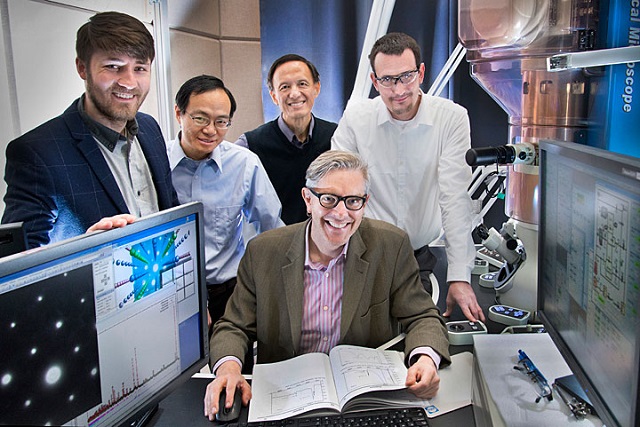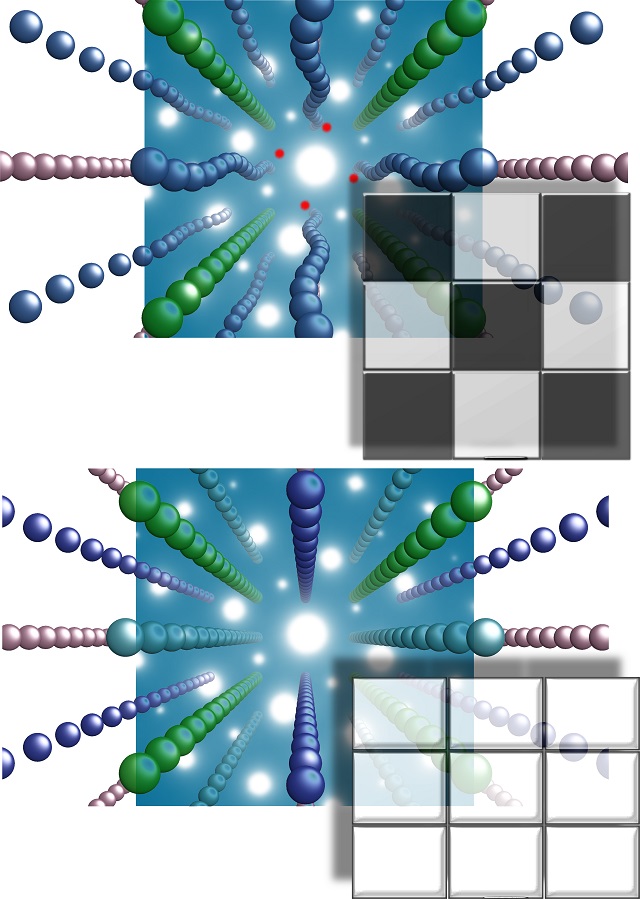 Team members conducting research at Brookhaven Lab, led by Simon Billinge of Brookhaven and Columbia Engineering (seated), included (l to r) Columbia U graduate student Ben Frandsen and Weiguo Yin, Yimei Zhu, and Emil Bozin of Brookhaven's Condensed Matter Physics and Materials Science Department. They used the aberation-corrected electron microscope in Zhu's lab to conduct electron diffraction experiments that were a key component of this study. Collaborators not shown: Hefei Hu, formerly of Brookhaven Lab and now at Intel, Yasumasa Nozaki and Hiroshi Kageyama of Kyoto University, and Yasutomo Uemura of Columbia.
Team members conducting research at Brookhaven Lab, led by Simon Billinge of Brookhaven and Columbia Engineering (seated), included (l to r) Columbia U graduate student Ben Frandsen and Weiguo Yin, Yimei Zhu, and Emil Bozin of Brookhaven's Condensed Matter Physics and Materials Science Department. They used the aberation-corrected electron microscope in Zhu's lab to conduct electron diffraction experiments that were a key component of this study. Collaborators not shown: Hefei Hu, formerly of Brookhaven Lab and now at Intel, Yasumasa Nozaki and Hiroshi Kageyama of Kyoto University, and Yasutomo Uemura of Columbia.
An unexpected form of electronic order has been discovered in a new unconventional superconductor family, by a collaborating team of researchers belonging to the Brookhaven National Laboratory, Columbia Physics, Columbia Engineering and the Kyoto University. This discovery confirms a connection between new titanium-oxypnictide superconductors and the common iron-pnictides and cuprates. The finding offers a new family of materials that can help researchers gain more knowledge about the secrets of high-temperature superconductivity.
Finding this new material is a bit like an archeologist finding a new Egyptian pharaoh's tomb. As we try and solve the mysteries behind unconventional superconductivity, we need to discover different but related systems to give us a more complete picture of what is going on—just as a new tomb will turn up treasures not found before, giving a more complete picture of ancient Egyptian society.
Simon Billinge, the leader of the research team and a physicist at Brookhaven Lab
A more energy-efficient future could be created by harnessing superconductivity’s power. However most superconductors function at -273°C, which is a very low temperature, and they cannot be used for regular everyday applications.
In the 1980s, researchers discovered superconductors that worked at comparatively higher temperatures. While this was a major advancement, this phenomenon could not take place at room temperature. However, this discovery provided hope that the reason for superconductivity and the ability to carry current without any losses could be understood and would help scientists create new materials. Each of these discoveries has provided more knowledge about superconductivity.
When interaction takes place between electrons in high-temperature superconductors, sometimes the electrons pair up and at other times they avoid each other. This is a mystery that scientists are still trying to understand. "Charge density waves" and other such special types of electronic states have been discovered. Here, the charges group together to form stripes and checkerboard patterns. The "translational symmetry" of the material is broken by both these patterns. Translational symmetry is the repetition of sameness that occurs when movement occurs across the surface.
Broken rotational symmetry without any modification in translational symmetry is another pattern that was observed by scientists in two popular high-temperature superconductor classes. This is called as nematic order, where all the spaces on the checkerboard are white. However, shapes of these spaces get distorted from a square form to a rectangular form. Based upon the direction faced during turning around repetitively on a single space, the adjacent space becomes farther or nearer. This unexpected state was observed in iron-pnictides and cuprates. Researchers wanted to find out if this electronic order could be seen in a new class of titanium-oxypnictide high-temperature superconductors.

Ripples extending down the chain of atoms breaks translational symmetry (like a checkerboard with black and white squares), which would cause extra spots in the diffraction pattern (shown as red dots in the underlying diffraction pattern). Bottom: Stretching along one direction breaks rotational symmetry but not translational symmetry (like a checkerboard with identical squares but stretched in one of the directions), causing no additional diffraction spots. The experiments proved these new superconductors have the second type of electron density distribution, called a nematic. Image credit: Ben Frandsen
These titanium-oxypnictide compounds are structurally similar to the other exotic superconductor systems, and they had all the telltale signs of a broken symmetry, such as anomalies in resistivity and thermodynamic measurements. But there was no sign of any kind of charge density wave in any previous measurement. It was a mystery. It was a natural for us to jump on this problem.
Emil Bozin, at Brookhaven
The research team studied the broken rotational symmetry effect using samples that were given by the Hiroshi Kageyama group at Kyoto University. This query had been raised by Columbia’s Tomo Uemura. Two types of diffraction studies were performed by the research team. At Brookhaven Lab, electron diffraction experiments were performed using a transmission electron microscope. At the Los Alamos Neutron Science Center at DOE's Los Alamos National Laboratory, the researchers performed neutron scattering experiments.
Ben Frandsen, the first author on the research paper, and a graduate student in physics at Columbia says that, "We used these techniques to observe the pattern formed by beams of particles shot through powder samples of the superconductors under a range of temperatures and other conditions to see if there's a structural change that corresponds to the formation of this special type of nematic state."
A telltale symmetry that broke distortion at low temperature was observed through the experiments. The specific nematic nature of the order was established by theorists and experimentalists.
Simon Billinge commented, "Critical in this study was the fact that we could rapidly bring to bear multiple complementary experimental methods, together with crucial theoretical insights—something made easy by having most of the expertise in residence at Brookhaven Lab and wonderfully strong collaborations with colleagues at Columbia and beyond."
The finding of nematicity in titanium-oxypnictides and their property of bridging cuprate and iron-pnictide high-temperature superconductors through their chemical and structural properties, make these materials very important in aiding the endeavor to gain more knowledge about electronic symmetry breaking in superconductivity.
This new pharaoh's tomb indeed contained a treasure: nematicity.
Simon Billinge
The U.S. National Science Foundation, DOE Office of Science, the Japan Atomic Energy Agency, the Japan Society of the Promotion of Science, and the Friends of Todai Inc. have provided support for this study.
The findings of this study have been published in the Nature Communications journal.
References